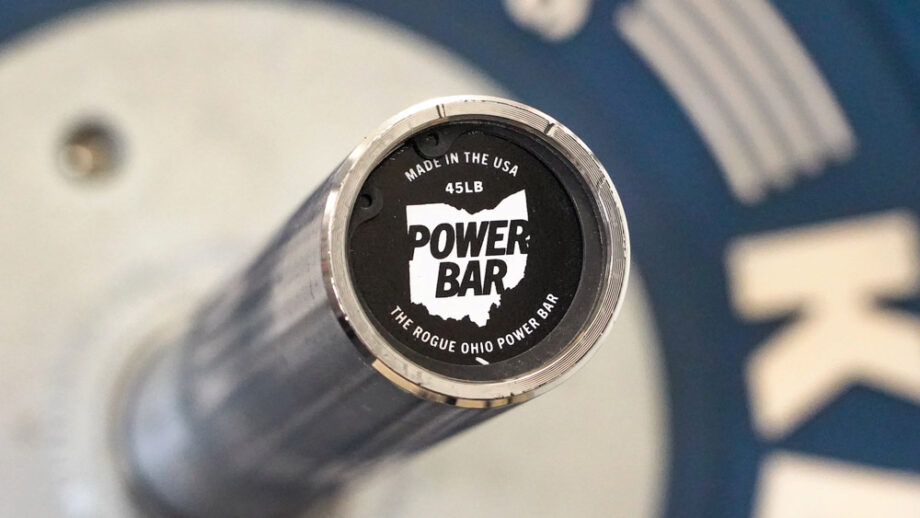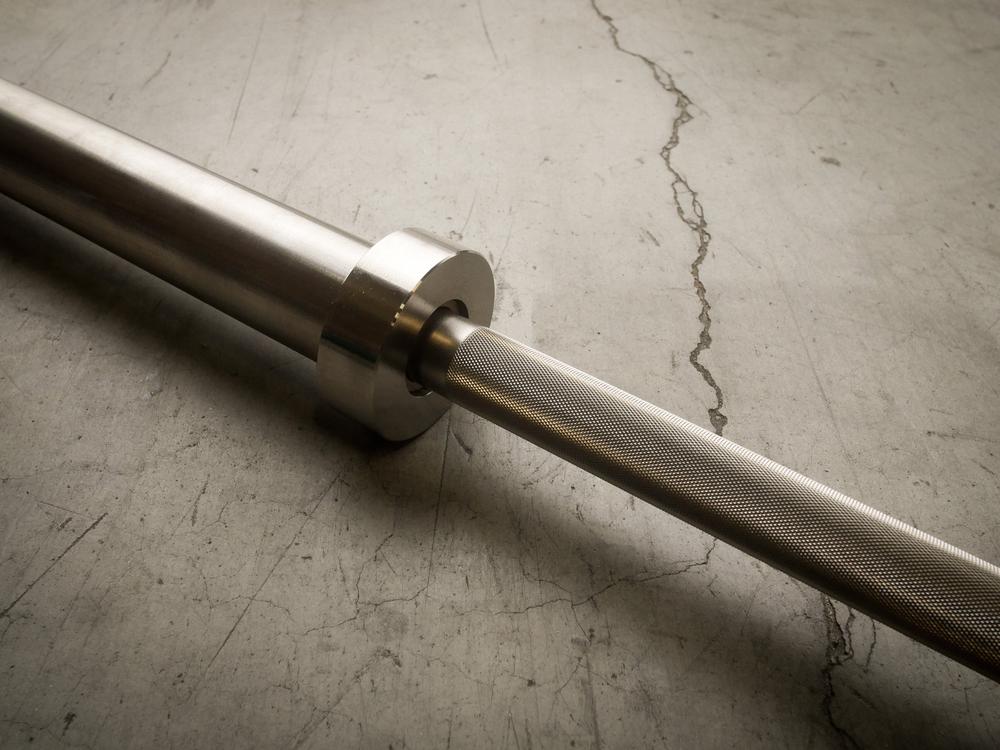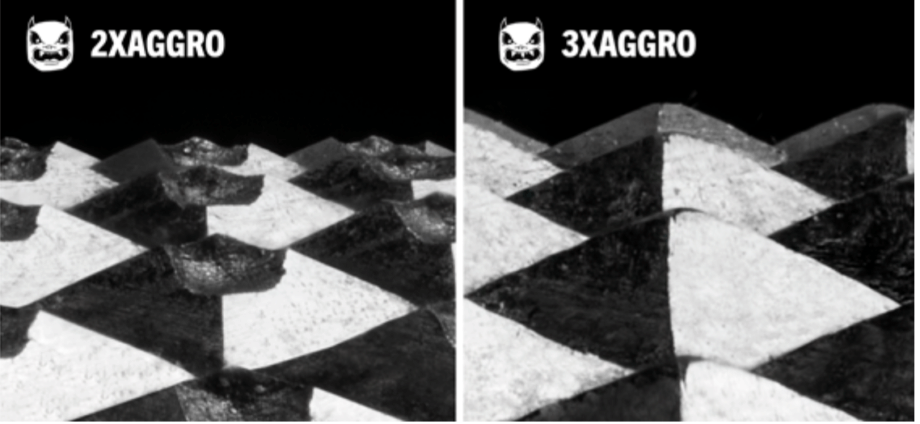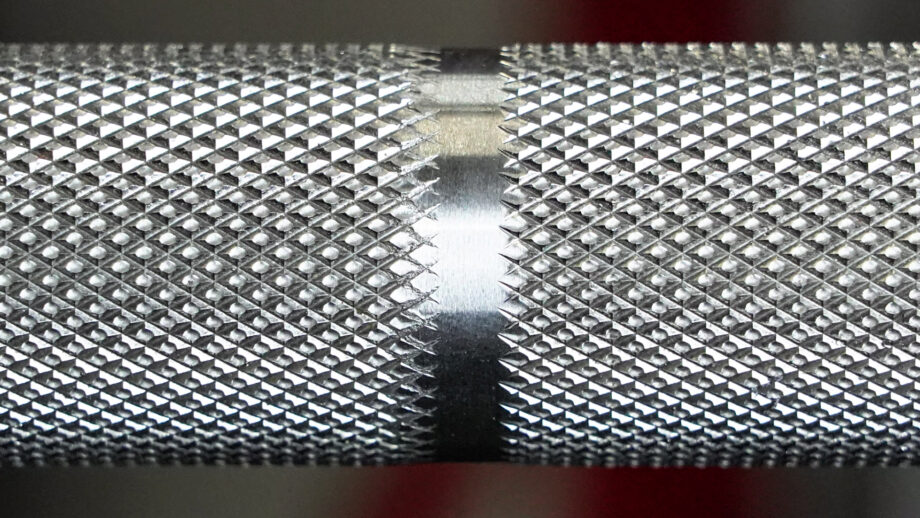We test and review fitness products based on an independent, multi-point methodology. If you use our links to purchase something, we may earn a commission. Read our disclosures.
Have you heard the term “barbell knurling” and wondered what exactly was being discussed? Olympic Barbell Knurl is something seen in nearly every home gym in the world and although it can seem like a small feature, it’s actually quite important and highly debated. In this review, I want to tell you what it is, why it matters, and examples of both good and bad knurling patterns.
What is Olympic Barbell Knurling?

Barbell knurling is the crosshatch pattern on the shaft of Olympic Barbells that is intended to increase friction between your hands and the bar and thus improving grip.
Barbell knurling varies greatly– not only on how deep it’s cut into the steel but also on the pattern. It’s also affected by the finish that’s applied over the top. If it’s a paint like Cerakote, then it won’t feel as aggressive as when it came off the line. Same with Chrome, and nearly every finish that’s applied. This is one reason stainless steel bars are so nice to have as they don’t corrode, but they also allow the trainee to feel the knurl without any coating between their hand and the bar.
Video Review

What Are The Different Types of Knurling?

Although nearly every barbell has a different knurl, they all pretty much conform to the same basic shapes.
The three types of knurling that were labeled by Chris Duffin of Kabuki Strength and have been adopted by myself and others are as follows:
- Hill
- Pointy Mountain
- Volcano

A Hill Knurl Pattern is often not initially designed to be a hill, but ends up happening from prolonged use and abuse on a barbell that uses mild (soft) steel. A Hill Knurl is one in which the individual “diamonds” have rounded tops instead of points. The rounded tops lead to a knurl feeling less aggressive and therefore more difficult to hold onto. When you’re going for a max clean and jerk, you want the bar to dig in. Even if you’re just doing warm-up reps for barbell rows, you don’t want your grip being the limiting factor.
A Hill Knurl Pattern on a barbell is the worst type of knurl there is, in my opinion. Knurling is there to help improve your grip and holding power on the bar. If you’re just trying to improve your grip and that’s the main focus of the lift, then a passive, hill knurl pattern is fine. But grip strength improvements are most often ancillary to the other parts of your body you’re trying to strengthen in training.

A Pointy Mountain Knurl Pattern is essentially what you’d expect. It’s a diamond shape with a point that makes the most contact with the skin of the hand. This drives into the skin and allows the bar to stick better during movements like deadlifts. This type of knurling pattern is commonly found on very aggressive power bars designed for one rep maxes in powerlifting competitions. It’s also found on many different deadlift bars.
The thought with a Pointy Mountain Knurl is that because it’s cut deep and has a sharp point and feels more aggressive, then it must work better. Basically, if it hurts more, it works better. Unfortunately, this has often been the view on many things in training and is simply untrue. Although an aggressive Pointy Mountain type of knurl can be beneficial, it is not optimal for most people or movements, in my opinion.

A Volcano Knurl Pattern is the most optimal barbell knurling pattern that is currently available. Rather than just the sharp points on the Pointy Mountain Knurl providing the friction, Volcano Knurl has a “rim” of sorts that is the sharp point of contact with the hand that provides grip. Instead of just a sharp point, a Volcano Knurl has a rim/circle that is sharp which is more surface area providing grip to the hand.
Think of it this way: rather than a needle making contact with the hand, it’s the rim of the volcano looking shape. That means there are four points of contact in the same amount of area versus one.
If you’re going to buy a barbell, I suggest one with a Volcano Knurl for most people and training styles (especially for powerlifting where the amount of weight is extremely high.)
Why Does the Knurl on a Barbell Matter?

Have you ever been doing a high rep set of deadlifts and you get to the end of your set and instead of your back rounding or your legs giving out, you lose grip with the bar? Now, obviously this could be a sign of your grip needing to be strengthened, but if you had a barbell that provided more friction via the knurl then you may have been able to stick out the set.
Your grip on the bar should be the least contributing factor to you completing a lift or not. If you’re at a powerlifting meet and you’re attempting a PR, the last thing you want to prevent you from doing so is the barbell slipping out of your hand on a deadlift.

Or, think of it like this for those that train in a home gym alone. If you’re doing sets of bench press with a suicide grip and the bar slips out of your hands, hits your chest, and then knocks you out, there could be some serious implications. Now, you shouldn’t be lifting without spotter’s arms or with a suicide grip, but that doesn’t stop many people.
These are all reasons why the knurl on your barbell matters. It’s not just for aesthetic purposes but provides real benefit to the performance and safety of the lifter. Check out the best weight benches guide here.
Barbell Knurl Examples

With all of the barbells that are available today, there are a variety of knurling patterns.
For Volcano Knurl, which is optimal for most people in my opinion, there are a few notable options.
Best Power Bar
Rogue Ohio Power Bar

Product Highlights
- Volcano knurl provides a great grip
- IPF-approved
- Lifetime warranty
- Four coating options: bare steel, black zinc, Cerakote, and stainless steel
- 205K PSI tensile strength
Pros & Cons
Pros
- Great value
- Volcano knurl
- Fantastic grip
- IPF-approved
- Lifetime warranty
- Four coating options: bare steel, black zinc, Cerakote, and stainless steel
- Made in the USA
- 205K PSI tensile strength
- F-8R rating
- Self-oiling bronze bushings
Cons
- 205K PSI tensile strength is not the strongest on the market
- Some may feel the knurling is too passive
- Bare steel Version rusts quickly
Bottom Line
The Rogue Ohio Power Bar is the power bar we recommend most often. You cannot spend less and get a better bar. You can spend more, and depending on your preferences get something maybe better, but even then, it's debatable.
The Rogue Ohio Power Bar has been our pick for the best power bar for most people for three years running. It uses a volcano knurl, is made in the USA, and is very affordable.
Upgrade Power Bar
Kabuki Strength Power Bar

Product Highlights
- 29-mm shaft
- Powerlifting marks
- Aggressive knurl
- 210K PSI tensile strength
- Lifetime warranty
- Textured sleeves
Pros & Cons
Pros
- Strongest barbell on the market
- Durable, volcano-style knurling
- 250K tensile strength
- Dual marks on center knurling
- Made in the USA
- Available in multiple finishes
- Meets IPF specs
Cons
- Very expensive
- Bare steel is prone to corrosion
- Lack of consistent knurling
Bottom Line
After testing and reviewing the Kabuki New Gen Power Bar for over a year, we can confidently say it's one of our arsenal's best and most used barbells.
The Kabuki Strength New Gen Power Bar also has a Volcano knurl, is designed for powerlifting and uses the strongest steel used in any barbell on the market–250K PSI Tensile Strength. In fact, it’s such strong steel that instead of the points on the knurling turning to hills on the section that rests on the best squat racks j-cups, it tears through the UHMW plastic. The knurling is finer than what’s seen on the Rogue OPB, but not worse. Just different and meets different people’s preferences.

Eleiko makes power bars, but what they’re known most for is their Olympic Weightlifting barbells. They use a Volcano-type knurl that is cut at various depths depending on its application. Training bars have a shallower depth knurl while competition bars are deeper and therefore more aggressive.

The most unique barbell knurling in the world is the Uesaka Weightlifting Bars. They’ve kind of taken this fact and now use the phrase, “Uniquely Uesaka” as their tagline. What makes their knurling unique is that rather than cutting into the steel, they use special machines that press into the bar shafts. They say the knurling is “hand-pressed” although I’m not entirely sure what that means and they haven’t published much information on their process. Regardless, it’s an extremely unique looking and feeling knurl and truly is special.
Further reading

Have you heard the term “barbell knurling” and wondered what exactly was being discussed? Olympic Barbell Knurl is something seen in nearly every home gym in the world and although it can seem like a small feature, it’s actually quite important and highly debated. In this review, I want to tell you what it is, why it matters, and examples of both good and bad knurling patterns.What is Olympic Barbell Knurling? » Read more about: What is Barbell Knurling and Why It Matters » Read more

Are you tired of the stains and smells in your workout clothes? Learn about the best detergent for sweaty clothes here! Read more

How does an Olympic plate loadable weighted vest compare to traditional weighted vests? Find out in our Kensui EZ-Vest Weighted Vest review. Read more

Find out if this bougie plant-based meal delivery service is worth your hard-earned money in our Sakara Life reviews. Read more

